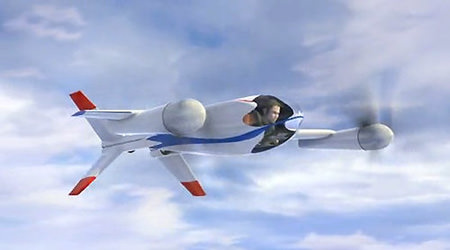[/caption]
Forget about jetpacks or flying cars. How about your own personal stealth aircraft? NASA has unveiled the Puffin, an experimental electrically propelled, super-quiet, tilt-rotor, hover-capable one-man aircraft. According to Scientific American, the 3.7-meter-long, 4.1-meter-wingspan craft is designed with lightweight carbon-fiber composites to weigh in at 135 kilograms (not including 45 kilograms of rechargeable lithium phosphate batteries.) The Puffin can cruise at 240 kilometers per hour, but for those high speed chases, can zoom at more than 480 kph. See video below.
Since it doesn’t have an air-breathing engine, the Puffin is not limited by thin air. So, basically, it doesn’t have a flight ceiling. The designers say it could go up to about 9,150 meters before its energy runs low enough to drive it to descend. With current state-of-the-art batteries, it has a range of just 80 kilometers if cruising, “but many researchers are proposing a tripling of current battery energy densities in the next five to seven years, so we could see a range of 240 to 320 kilometers by 2017,” says researcher Mark Moore, an aerospace engineer at NASA’s Langley Research Center in Hampton, Va. He and his colleagues unveiled the Puffin design on January 20, 2010 at an American Helicopter Society meeting in San Francisco.
For takeoff and landing, the Puffin stands upright. But during flight the whole aircraft pitches forward, putting the the pilot in the prone position, like in a hang glider.
Of course, the original idea for this personal aircraft is for covert military operations. But if they can design them safe enough and cheap enough, everyone will want one. It could change our ideas about electric propulsion and personal aircraft.
By March, the researchers plan on finishing a one third–size, hover-capable Puffin demonstrator, and in the three months following that they will begin investigating how well it transitions from cruise to hover flight.
Hat tip to my sister Alice!


Most of us don’t think in kph. 240 kph = 150 mph & 480 kph = 300 mph.
This is the most amazing thing I have ever seen.
I’d hate to see an intoxicated person get into one of these though :p
Bartender: I’ll have whatever the guys at Langley are drinking (and smoking). 🙂
This is for covert military operations? NASA is a civilian agency, no?
From what I can see in the video it appears that they are using some strange new form of the word “design” that I’m not familiar with…
I’m curious to see if there is more information behind this design – it just appears more like a great wishful thinking video – it appears I can hook up a propeller to my battery powered screwdriver and fly around like Mary Poppins…
Was that a FedEx product placement?
:facepalm:
“Puffin can cruise at 240 kilometers per hour ….. With current state-of-the-art batteries, it has a range of just 80 kilometers if cruising”
Ah, the limits of batteries. 20 minutes of flight time tops. Still, to visit friends within a 50 mile radius and be there in 20 is nothing to sneeze at.
# Craigboy Says:
January 21st, 2010 at 10:51 am
“Most of us don’t think in kph.”
Most of you backward yanks anyway… Check out the metric system – the rest of the civilized word has!
PS – Americans, don’t take offense. I still loves ya…
And when I say word, I really mean world.
It reminded me of Hitler’s planned aircrafts. I watched some TV show about 2nd world war guns…
I’m surprised is NASA is involved in this. Seems a bit outside their core mission, especially in light of their lack of funding as of late.
That thing makes my neck ache just looking at it! Laying in a prone position and looking forward isn’t a position I’d want to be in for very long… Graham Hawkins has a mini-sub with that same position built into it and it has the same problem… just not practical for long duration without a chin rest.
Maybe this would provide a new area of income if it gets off the ground (sorry the pun was too easy)
Does it come in Black?
@ Craigboy January 21st, 2010 at 10:51 am
What? The metric system is the fundamental standard for all science (and aeronautics.)
Why? As the whole system is universally base ten (Most Americans I believe still have ten toes and ten fingers, but I might be wrong there.) Regardless of the units, (except time), the scales are in base ten and not arbitrary scales like Fahrenheit, inches, feet, miles etc. I.e. 1000 metres is 1 kilometre instead of whatever number of feet just happen to be in a mile, Anyone with half-a-brain can see the advantages in simple calculation.
Sadly, most who stubbornly think in mph etc. just don’t get it. Pity.
Join the rest of the world guys and don’t be such narrow-minded isolationists!
Good idea. An environmental mode of transport. Works underwater and on land, why not the sky too!
The only question. How do you get in and out of it?
Perhaps ol’ George Jetson in the 1960s was on the right track!
@Astrofiend, Crumb: You guys beat me to it in response to Craigboy. I live in the US, and am ashamed to admit that most “yanks” have little or no idea how the metric system works. I remember the hue and cry here 20 years ago when the US attempted to implement the Metric system. It’s no wonder Bush was elected twice. Any room down under Astrofiend?